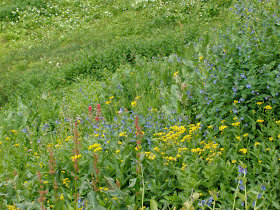
Second Evening in the Snowy Range
Reclining in my tent sipping some tea made with gooseberry current blossoms, newly sprouted pine needles (quite high in vitamin C), a few marsh marigold blossoms and a bit of turbinado steeped in water from a nearby alpine snow-fed stream, all heated on rocks at the edge of a pinewood fire.
Mixed a healthy batch of the o’er abundant marsh marigold buds and blossoms and tender young leaves into my evening meal. Couldn’t quite make out the taste of the marigolds for the other ingredients, so I might try a dish unalloyed with so many other ingredients that I might more accurately gauge this common high mountain plant’s culinary value. Perhaps mostly buds and only the freshest leaves (they are reportedly tougher with age), sautéed in first cold-pressed extra-virgin olive oil with a bit of cumin and a dash of cayenne.
Marsh Marigolds


I may add some wild onions if I happen across some, despite my growing aversion to domestic onions, and might go on a hike to seek out some Boletus edulus, though it might be a bit early for this large wild mushroom indigenous to this region to fruit. These “King Boletes” are a very large fungus with a brown cap, spongy yellow porous spore-producing underside with a rather bulbous (though not proceeding from a bulb, like the generally poisonous Amanitas—an appellation which means “humility” in Sanskrit. Amanita muscaria is one of the less poisonous members of this family that is the well known red white-spotted mushroom from fairy-tales—think the Cheshire Cat’s perch) white stalk with darker vertical striations. These fungi can grow to over a foot in diameter, and there are reports of some growing to somewhere approaching two feet in breadth.
Else if I happen across one of a handful of other species of wild edible mushrooms I can reliably identify that rate in the “choice” category, I might add these to the Caltha leptosepala buds and leaves dish. Three or four Lactarius deliciosus (delicious milky-cap) would be as good or better than some Boletes. These bright orange mushrooms that bruise fluorescent green (not to be mistaken for the similar looking Jack O’ Lantern, another bright orange mushroom that actually glows-in-the-dark) are amongst the most highly touted wild mushroom that grows in the Rocky Mountains—though once they begin to rot, they emit an odor best compared to rotting fish. Even some properly identified puffballs would be cool, though I should note puffballs can resemble unopened Amanita bulbs, which bear such names as "death cap" and destroying angel.
Lactarius deliciosus and Boletus edulis (stock photos--didn't find any)
.jpg)

Third Evening in the Snowy Range
Made an extraordinary stirfry with a big batch of marsh marigold buds and dogtooth violet roots (rather a misnomer, as the flowers are quite yellow) a lovely mountain flower also known as troutlily, fawnlily, or adder's tongue (Erythronium grandiflorum). These corms (proper name for these roots/bulbs) are amazingly good, and taste rather like a mix between bean sprouts and water chestnuts. The marsh marigold buds taste a bit like tiny brussel sprouts, but without what some find the disagreeable taste associated with said sprouts.


Troutlily


Conclusion: wild foods are fun and taste good too! Please try them out with appropriate knowledge and caution--some look-alikes may be poison!!




